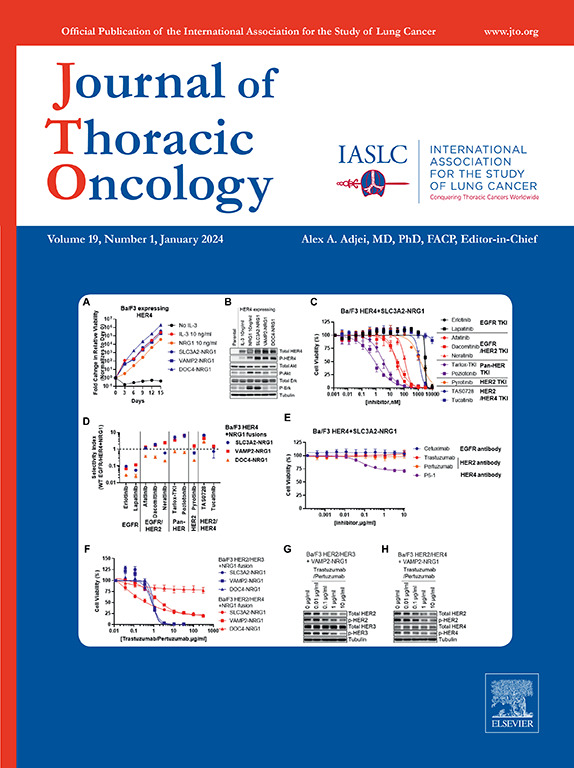真实世界人群中奥希替尼相关心脏毒性的风险和可逆性
IF 21
1区 医学
Q1 ONCOLOGY
引用次数: 0
摘要
简介奥希替尼是第三代表皮生长因子受体酪氨酸激酶抑制剂,作为转移性非小细胞肺癌(NSCLC)的一线治疗药物,奥希替尼已显示出显著的生存优势,但其潜在的心脏毒性也引起了人们的关注,尤其是在实际临床环境中。我们旨在研究与奥希替尼相关的心脏毒性的发生率、风险因素和可逆性:我们分析了2016年5月至2023年4月在两个癌症中心接受奥希替尼治疗的1126例NSCLC患者。奥西美替尼相关心脏毒性定义为奥西美替尼相关心脏功能障碍(ORCD)、新发心律失常和心源性死亡的综合。总随访时间为20.6(10.8-35.2)个月:结果:奥西莫替尼的中位用药时间为12.4个月。与奥希替尼相关的心脏毒性发生率为4.7%。高龄(调整后危险比,95%置信区间;1.07 [1.04-1.09],P <0.001)、心衰病史(HF;3.35 [1.67-9.64],P = 0.025)、心房颤动(AF;3.42 [1.27-9.22],P = 0.015)和基线左心室低应变(0.87 [0.79-0.96],P = 0.005)与心脏毒性的发生独立相关。ORCD 的恢复率为 82.4%,停药和不停药的患者之间没有差异:结论:在现实世界中,与奥希替尼相关的心脏毒性发生率为4.7%,其中需要心脏介入治疗的ORCD发生率为3.4%,高于之前的报道。考虑到奥希替尼的长期用药以及与心脏毒性相关的死亡率升高,警惕性监测至关重要,尤其是对于高龄、有心房颤动、房颤病史或左心室基线应变降低的患者。本文章由计算机程序翻译,如有差异,请以英文原文为准。

The Risk and Reversibility of Osimertinib-Related Cardiotoxicity in a Real-World Population
Introduction
Although osimertinib, a third-generation EGFR tyrosine kinase inhibitor, as the first-line therapy for metastatic NSCLC was found to have substantial survival benefits, concerns have arisen regarding its potential cardiotoxicity, particularly in real-world clinical settings. We aimed to investigate the incidence, risk factors, and reversibility of osimertinib-related cardiotoxicity.
Methods
We analyzed 1126 patients with NSCLC treated with osimertinib from May 2016 to April 2023 in two cancer centers. Osimertinib-related cardiotoxicity was defined as a composite of osimertinib-related cardiac dysfunction (ORCD), newly developed arrhythmia, and cardiac death. Total follow-up duration was 20.6 (10.8–35.2) months.
Results
The osimertinib was administered for a median of 12.4 months. The incidence of osimertinib-related cardiotoxicity was 4.7%. Advanced age (adjusted hazard ratio with 95% confidence interval: 1.07 [1.04–1.09], p < 0.001), a history of heart failure (3.35 [1.67–9.64], p = 0.025), atrial fibrillation (3.42 [1.27–9.22], p = 0.015), and baseline low left ventricle strain (0.87 [0.79–0.96], p = 0.005) were independently associated with development of cardiotoxicity. The recovery rate of ORCD was 82.4%, which did not differ between patients who discontinued medication and those who did not.
Conclusions
In real-world practice, the incidence of osimertinib-related cardiotoxicity was 4.7%, including 3.4% for ORCD requiring cardiologic intervention, which is higher than previously reported. Given the long-term medication of osimertinib and increased mortality associated with cardiotoxicity, vigilant monitoring is crucial, especially in patients with advanced age, history of heart failure, atrial fibrillation, or decreased baseline left ventricular strain.
求助全文
通过发布文献求助,成功后即可免费获取论文全文。
去求助
来源期刊

Journal of Thoracic Oncology
医学-呼吸系统
CiteScore
36.00
自引率
3.90%
发文量
1406
审稿时长
13 days
期刊介绍:
Journal of Thoracic Oncology (JTO), the official journal of the International Association for the Study of Lung Cancer,is the primary educational and informational publication for topics relevant to the prevention, detection, diagnosis, and treatment of all thoracic malignancies.The readship includes epidemiologists, medical oncologists, radiation oncologists, thoracic surgeons, pulmonologists, radiologists, pathologists, nuclear medicine physicians, and research scientists with a special interest in thoracic oncology.
 求助内容:
求助内容: 应助结果提醒方式:
应助结果提醒方式:


